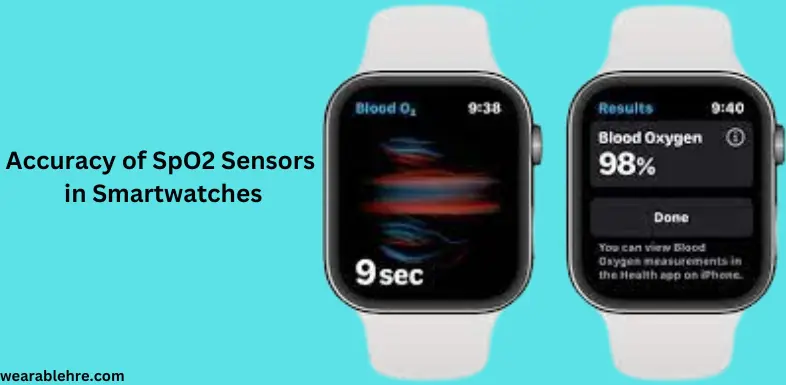Blood oxygen saturation, often referred to as SpO2, is a key metric used to assess the amount of oxygen in our blood.
It plays a crucial role in monitoring respiratory health, especially during physical activities or at higher altitudes.
With the advent of smartwatches equipped with oxygen sensors, individuals can now conveniently monitor their oxygen levels on the go.
But just how accurate are these oxygen sensors in our smartwatches?
Are they trustworthy enough to provide accurate readings that can inform our health decisions?
Understanding the accuracy of oxygen sensors is vital, as it can have a direct impact on users’ peace of mind and the reliability of health data collected.
So, let’s delve into the facts and separate the buzz from reality.
What are the Oxygen Sensors?
Oxygen sensors in smartwatches employ innovative technology to measure oxygen saturation levels non-invasively.
These sensors utilize a combination of light sources and photodiodes to estimate the percentage of oxygen bound to hemoglobin in the blood.
The two primary types of oxygen sensors commonly found in smartwatches are optical sensors and electrical sensors.
- Optical sensors work by emitting light, typically red and infrared, into the skin and measuring the light absorption to determine oxygen levels.
- Electrical sensors, on the other hand, employ electrical currents to gauge the impedance changes in the skin, indirectly estimating oxygen saturation.
One of the key benefits of oxygen sensors in smartwatches is their ability to provide on-the-spot readings without the need for invasive blood sampling.
Users can conveniently place their finger on the sensor or wear the smartwatch on their wrist to obtain instant oxygen saturation measurements.
While they can offer valuable insights into overall trends and patterns, they may not provide the same level of accuracy as professional medical equipment.
Factors Affecting the Accuracy of Oxygen Sensors in Smartwatches
While oxygen sensors in smartwatches provide a convenient way to monitor oxygen saturation, there are several factors that can impact their accuracy.
It’s important to be aware of these factors to ensure the most reliable readings possible.
1. Environmental Factors
The surrounding environment can play a role in the accuracy of oxygen sensor measurements.
Factors such as high altitude, extreme temperatures, and poor lighting conditions may affect the sensor’s ability to obtain accurate readings.
Additionally, motion artifacts caused by physical activity or hand movements can introduce errors in the measurements.
2. User-Related Factors
Certain user-related factors can influence the accuracy of oxygen sensor readings.
Skin pigmentation, for instance, can affect the penetration of light used by optical sensors, potentially leading to inaccurate results.
Similarly, nail polish, tattoos, or dirt on the skin can interfere with the sensor’s ability to obtain accurate measurements.
Proper sensor placement and ensuring clean skin can help mitigate these issues.
3. Technical Considerations
Oxygen sensors in smartwatches have inherent technical limitations that can affect accuracy.
These sensors are designed for general wellness purposes and may not undergo the same level of calibration and validation as medical-grade devices.
The algorithms used by the smartwatch to process the sensor data can also impact the accuracy of the readings.
Well, if you’re considering to buy a watch for SpO2 monitoring, here’s a complete guide on best smartwatches with oxygen sensors.
Tips for Accurate Readings of SpO2 Level
While using smartwatch oxygen sensors can be beneficial, it’s important to keep certain recommendations in mind to maximize the accuracy and usefulness of the measurements. Consider the following guidelines:
Proper Sensor Placement
Ensure that the smartwatch is worn correctly and the oxygen sensor is in contact with your skin. Follow the manufacturer’s instructions for sensor placement to obtain the most accurate readings.
Keep in mind that factors such as movement and external light sources can affect the sensor’s performance. So try to minimize these influences during measurements.
Maintain Clean Skin
Before using the oxygen sensor, ensure that your skin is clean and free from any substances that could interfere with accurate readings.
Remove any dirt, oil, or makeup from the skin in the area where the sensor makes contact. This will help optimize the sensor’s performance and accuracy.
Understand Limitations
Recognize that smartwatch oxygen sensors may not provide medical-grade accuracy.
While they offer valuable insights for general wellness tracking, they should not replace professional medical advice or diagnosis.
If you have specific health concerns or require highly accurate measurements. Consult with healthcare professionals and rely on medical-grade equipment.
Contextualize Readings
Interpret the oxygen saturation measurements in the context of your overall well-being.
Look for trends and changes rather than relying solely on individual readings. This will provide a more comprehensive understanding of your health patterns over time.
Consider Professional Advice
If you have specific health conditions or concerns, consult with healthcare professionals who can provide guidance based on medical-grade measurements.
They can help you understand the relevance of oxygen saturation levels in your specific situation and provide appropriate recommendations.
Wrapping it Up!
Smartwatch oxygen sensors offer convenient monitoring of oxygen saturation levels for overall wellness tracking.
However, their accuracy is influenced by factors like environmental conditions, user-related factors, and technical considerations.
Following guidelines for proper sensor placement, maintaining clean skin, and understanding context can optimize accuracy.
It’s important to note that smartwatch oxygen sensors are not medical-grade devices and should not replace professional medical advice.
Zuha is our expert author and editor with a passion for exploring the latest advancements in wearable technology. With a wealth of experience covering all the latest smartwatches and other wearables, she brings a depth of knowledge and insights to her work that few can match. From in-depth reviews to breaking news, she is dedicated to providing readers with the most up-to-date and informative content available.
